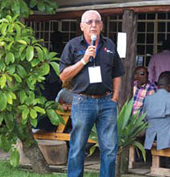 The 7th edition of IFTEX was very successful, according to all who attended. In every aspect the trade fair was rated as “excellent”. Both exhibitors and visitors were very impressed by this year’s quality and diversity of displayed flowers and creativity of stand building.
The 7th edition of IFTEX was very successful, according to all who attended. In every aspect the trade fair was rated as “excellent”. Both exhibitors and visitors were very impressed by this year’s quality and diversity of displayed flowers and creativity of stand building.
The three day event started off by the official opening held in the auditorium of the Oshwal Center in Westlands Nairobi, the place where the exhibition traditionally takes place. The guest of honor this year was the Kenyan Permanent Secretary for Trade, Dr. Chris Kiptoo. He praised all players in the flower industry for their contribution to Kenya’s export economy.
IFTEX was held this year along the newly launched FPA, a trade fair in line of the IFTEX mission, but especially set up for the vegetable, fruit and herb industry of Kenya. For this purpose about 50 growers of fresh produce were exhibiting in Fresh Produce Africa (FPA), the name of this new trade fair, and located in a separate hall adjacent to the IFTEX halls.
“Fresh Produce Africa” or FPA will be a platform for the fresh vegetables and fruits sector of Kenya and other African countries. It is totally new for two reasons: never before a trade fair with this profile has been organized in Africa and never before this concept has been implemented in Africa, a concept where international buyers are being invited to the continent where the product is being grown, as it is custom that producers go to the countries where the product is being sold, according to the organizers.

 We are alive at critical time where climate change is real. Generally, it has become a challenge for the farming fraternity to plan events because of the unpredictable weather patterns. As a result, for the agripreneurs, some has closed shops while others irrigation has been made inescapable. However, surface water is also unavailable in adequate amounts, making ground water an obvious choice.
We are alive at critical time where climate change is real. Generally, it has become a challenge for the farming fraternity to plan events because of the unpredictable weather patterns. As a result, for the agripreneurs, some has closed shops while others irrigation has been made inescapable. However, surface water is also unavailable in adequate amounts, making ground water an obvious choice. Kenya has been part of the international supply base over the past 20 years with the majority of the fruit going to France and Holland. In 2016, avocado contributed KES4.63 billion from 246,057 tons of fruits accounting for 8% by value of the fruit sub-sector. The value increased form 4.45Billion in2015 to 4.63 in 2016 which was a 4.2% increase from 2015. This was due to improved prices in the international market as well as opening of the Russian market that demands high volumes of Fuertes avocados which were not very popular in the European market.
Kenya has been part of the international supply base over the past 20 years with the majority of the fruit going to France and Holland. In 2016, avocado contributed KES4.63 billion from 246,057 tons of fruits accounting for 8% by value of the fruit sub-sector. The value increased form 4.45Billion in2015 to 4.63 in 2016 which was a 4.2% increase from 2015. This was due to improved prices in the international market as well as opening of the Russian market that demands high volumes of Fuertes avocados which were not very popular in the European market. Helping reconstruct a street boy emerging from the tough life in the Kenyan streets is not about the talk, it’s about the walk. It’s not about the what, it’s about the how. And it’s never about the will, it’s about the will. But how can you get it right if you are on the wrong part of the world? Naivasha Horticultural fair has been doing it and will do it. Their generous contribution in many areas has helped enormously. They have involved themselves in plentiful charitable projects which are of great help to the community at large.
Helping reconstruct a street boy emerging from the tough life in the Kenyan streets is not about the talk, it’s about the walk. It’s not about the what, it’s about the how. And it’s never about the will, it’s about the will. But how can you get it right if you are on the wrong part of the world? Naivasha Horticultural fair has been doing it and will do it. Their generous contribution in many areas has helped enormously. They have involved themselves in plentiful charitable projects which are of great help to the community at large. The 7th edition of IFTEX was very successful, according to all who attended. In every aspect the trade fair was rated as “excellent”. Both exhibitors and visitors were very impressed by this year’s quality and diversity of displayed flowers and creativity of stand building.
The 7th edition of IFTEX was very successful, according to all who attended. In every aspect the trade fair was rated as “excellent”. Both exhibitors and visitors were very impressed by this year’s quality and diversity of displayed flowers and creativity of stand building.